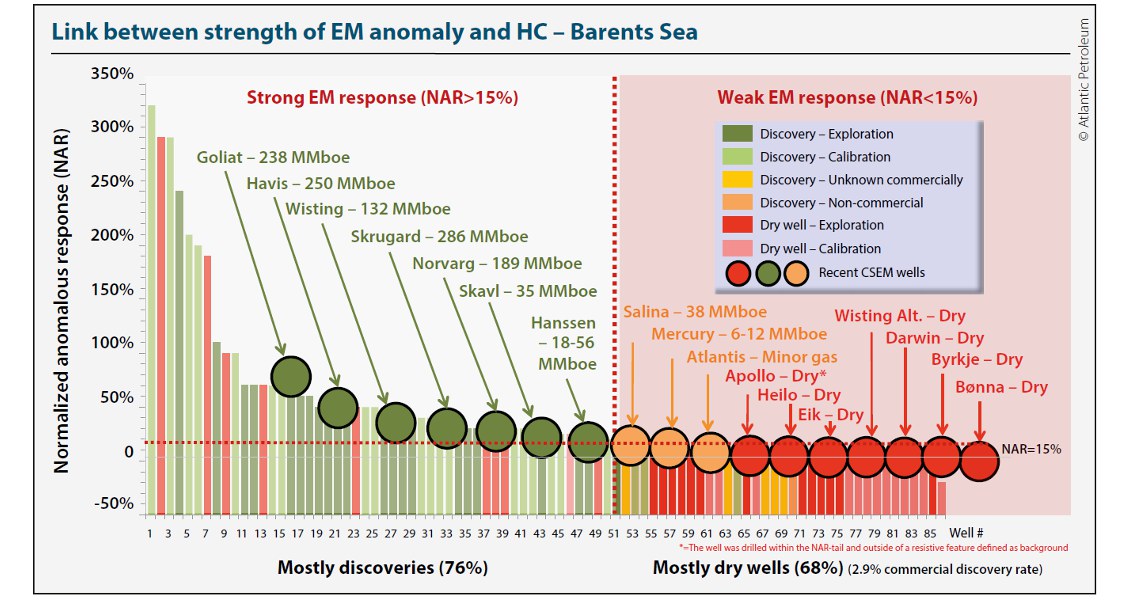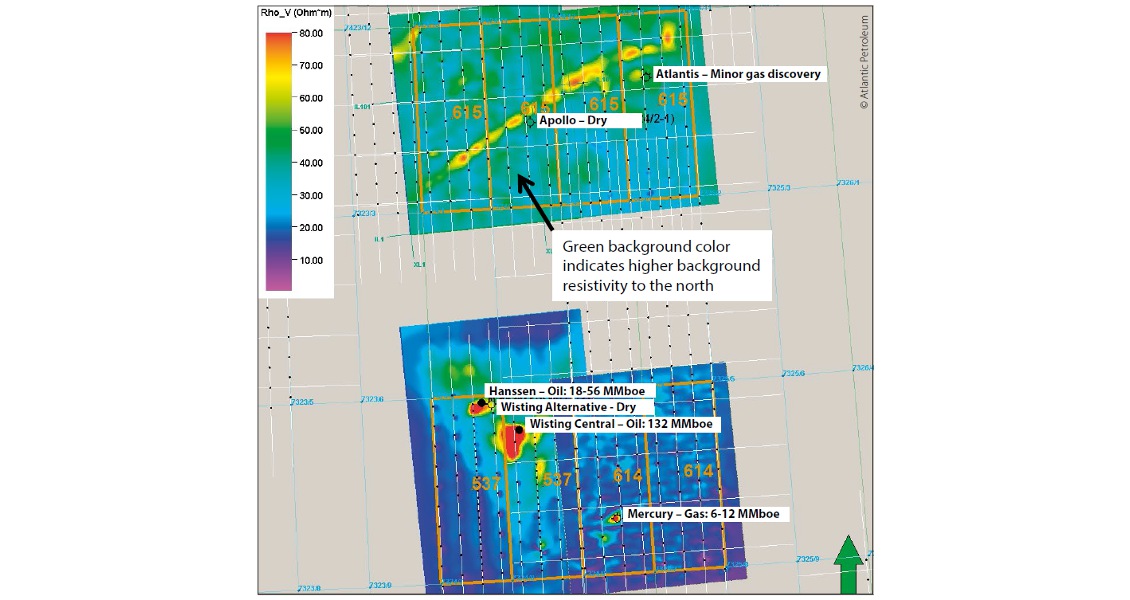The drilling campaign in the Hoop area last summer has only given very meager results. Statoil made two tiny gas discoveries (Atlantis, 7325/1-1 and Mercury, 7324/9-1), and one dry well (Apollo, 7324/2-1). This stands in sharp contrast to the two oil discoveries OMV previously made on Wisting (2013) and Hanssen (2014). How was it possible to miss so fundamentally?
Fabulously Good Correlation
It has long been known that there is a clear correlation between the response of electromagnetic measurements and the fluid content of a reservoir. Nowhere is this better demonstrated than in the Barents Sea. Jonny Hesthammer, Managing Director of Atlantic Petroleum Norway and professor at the University of Bergen, has shown that there is a clear correlation between the size of the EM anomalies (NAR = Normalized Amplitude Response) and the volume of hydrocarbons in the reservoir.
The drilling of Byrkje (7218/8- 1) in 2014 was a further confirmation that the lack of an anomaly results in a dry well. The Hanssen well (7324/7-2), however, which OMV drilled in early summer 2014, showed that a CSEM anomaly was associated with a small addition to the main findings obtained from the Wisting well.
“The results are startling,” says Hesthammer. “I have looked at EMGS’s inverted multi-client EM data from the Hoop area, and it simply shows an exceptionally good correlation between the strength and extent of observed EM anomalies and volumes of hydrocarbons. The largest EM anomaly in the area is related to Wisting, which is believed to have discovered 132 MMboe. The second largest anomaly in the area is associated with the Hanssen discovery where between 18 and 56 MMboe was detected. This anomaly is approximately a quarter of the size of Wisting, which fits well with proved reserves. And we must not forget Wisting Alternative, which was drilled outside the EM anomaly associated with the Hanssen discovery. The well targeted hydrocarbons in the Kobbe Formation. It was, however, dry – again in good agreement with the EM data shows.”
Because of the Wisting and Hanssen discoveries, the three holes drilled by Statoil in the Barents Sea last summer were followed with extraordinary interest. All three were a disappointment. For although small amounts of gas were found in the two wells (Atlantis and Mercury), it was in far from commercial quantities. They can at best be described as technical discoveries.
As Hesthammer explains: “Although there is an apparent anomaly associated with Mercury, the size is small, only about a third of that observed for Hanssen. Again it fits very well with the small gas volumes found [6–12 MMboe].
“There is simply a fabulously good correlation between an observed anomaly and the discovered amounts of hydrocarbons in this area.”
What about Apollo and Atlantis further north? These wells were drilled in an area with significantly higher background resistivity than that observed for wells further south. But the EM data is nonetheless compelling, according to Hesthammer.
“Apollo was drilled just outside a distinct resistive lineament, and it is not linked to any clear EM anomaly. There should therefore be no surprise that this well was dry,” he says. “For the Atlantis well the picture is more nuanced. There is no obvious anomaly associated with this prospect either, but EM data revealed slightly elevated resistivity, and it hangs nicely with the observation of small amounts of gas in the well.”
Can We Neglect Data?
 Jonny Hesthammer has extensive experience in the use of EM data in exploration for oil and gas. Based on the latest wells in the Barents Sea – including several disappointments – he claims that there is evidence of a clear correlation between the size of EM anomalies and the size of hydrocarbon discoveries in this geological province. (Source: Halfdan Carstens)The picture is now complete. For while the three discovery wells to the south are all associated with EM anomalies which fit with the hydrocarbon volumes that have been detected, the disappointing results from Apollo and Atlantis are also nicely explained, since the EM data does not show any apparent associated anomaly.
Jonny Hesthammer has extensive experience in the use of EM data in exploration for oil and gas. Based on the latest wells in the Barents Sea – including several disappointments – he claims that there is evidence of a clear correlation between the size of EM anomalies and the size of hydrocarbon discoveries in this geological province. (Source: Halfdan Carstens)The picture is now complete. For while the three discovery wells to the south are all associated with EM anomalies which fit with the hydrocarbon volumes that have been detected, the disappointing results from Apollo and Atlantis are also nicely explained, since the EM data does not show any apparent associated anomaly.
“Additionally, the results of Atlantis and Mercury show that EM has the sensitivity to fault blocks down to 1×1 km and hydrocarbon columns that are less than ten meters,” says the geologist with broad geophysical knowledge.
As many would argue, that means that it is very risky to explore in this part of the world without using EM data. “The data from the Hoop area is some of the most persuasive I have seen in terms of evidence that EM technology works,” concludes Jonny Hesthammer.
We, who sit on the sidelines, are left asking whether these results will be used in future drilling decisions. How many good correlations must there be before explorationists believe in a correlation between EM and hydrocarbons? How many dry wells will the Norwegian government subsidize for the conservative oil industry before realizing what new technology can contribute?






